Childhood Obesity and its Impact: Health and Society Assessment 2
VerifiedAdded on 2023/01/18
|9
|1838
|21
Project
AI Summary
This project provides a detailed analysis of childhood obesity, focusing on its prevalence and impact within the Australian context. The assessment begins by defining childhood obesity using BMI and highlighting its significance at individual, family, and community levels. It explores the relationship between childhood obesity and Australia's National Health Priority Areas (NHPA), including diabetes, cardiovascular diseases, and asthma. Furthermore, the project examines the influence of social determinants of health, specifically race/ethnicity, individual behaviors (dietary habits), and physical environmental factors. It also discusses an upstream nursing approach, emphasizing advocacy, collaborative leadership, and social marketing skills to address childhood obesity effectively. The project incorporates relevant literature and references to support its claims, providing a comprehensive overview of the issue.
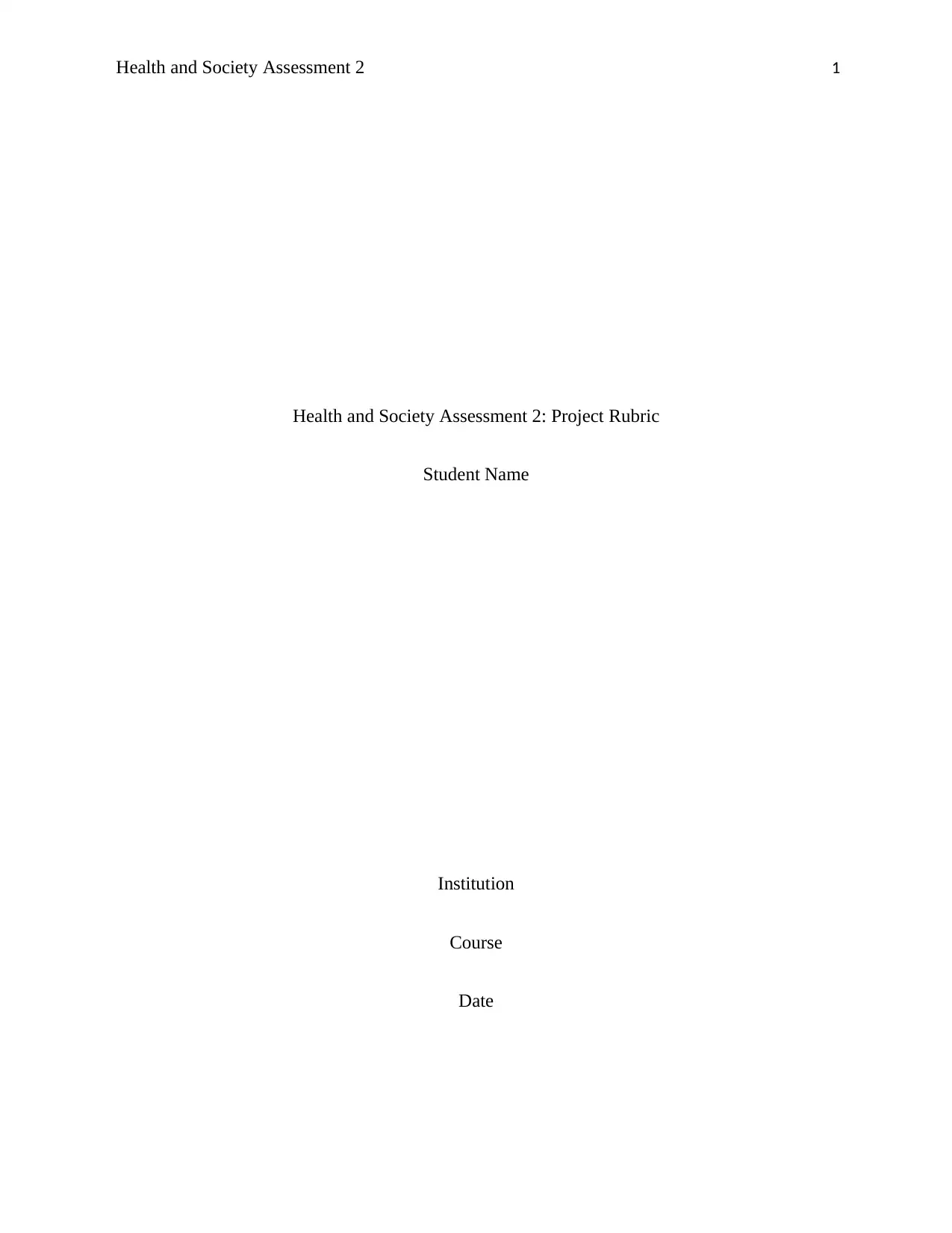
Health and Society Assessment 2 1
Health and Society Assessment 2: Project Rubric
Student Name
Institution
Course
Date
Health and Society Assessment 2: Project Rubric
Student Name
Institution
Course
Date
Paraphrase This Document
Need a fresh take? Get an instant paraphrase of this document with our AI Paraphraser
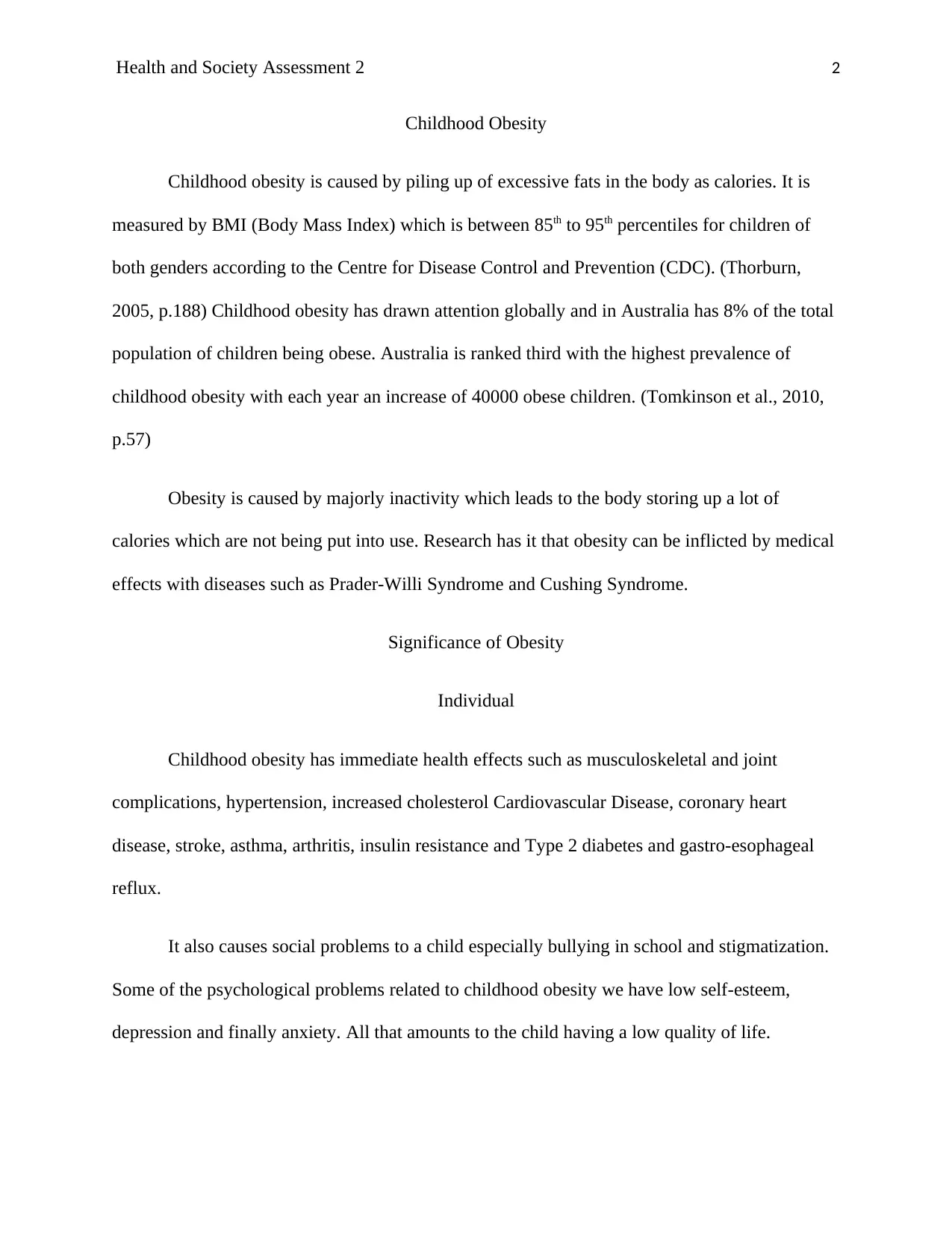
Health and Society Assessment 2 2
Childhood Obesity
Childhood obesity is caused by piling up of excessive fats in the body as calories. It is
measured by BMI (Body Mass Index) which is between 85th to 95th percentiles for children of
both genders according to the Centre for Disease Control and Prevention (CDC). (Thorburn,
2005, p.188) Childhood obesity has drawn attention globally and in Australia has 8% of the total
population of children being obese. Australia is ranked third with the highest prevalence of
childhood obesity with each year an increase of 40000 obese children. (Tomkinson et al., 2010,
p.57)
Obesity is caused by majorly inactivity which leads to the body storing up a lot of
calories which are not being put into use. Research has it that obesity can be inflicted by medical
effects with diseases such as Prader-Willi Syndrome and Cushing Syndrome.
Significance of Obesity
Individual
Childhood obesity has immediate health effects such as musculoskeletal and joint
complications, hypertension, increased cholesterol Cardiovascular Disease, coronary heart
disease, stroke, asthma, arthritis, insulin resistance and Type 2 diabetes and gastro-esophageal
reflux.
It also causes social problems to a child especially bullying in school and stigmatization.
Some of the psychological problems related to childhood obesity we have low self-esteem,
depression and finally anxiety. All that amounts to the child having a low quality of life.
Childhood Obesity
Childhood obesity is caused by piling up of excessive fats in the body as calories. It is
measured by BMI (Body Mass Index) which is between 85th to 95th percentiles for children of
both genders according to the Centre for Disease Control and Prevention (CDC). (Thorburn,
2005, p.188) Childhood obesity has drawn attention globally and in Australia has 8% of the total
population of children being obese. Australia is ranked third with the highest prevalence of
childhood obesity with each year an increase of 40000 obese children. (Tomkinson et al., 2010,
p.57)
Obesity is caused by majorly inactivity which leads to the body storing up a lot of
calories which are not being put into use. Research has it that obesity can be inflicted by medical
effects with diseases such as Prader-Willi Syndrome and Cushing Syndrome.
Significance of Obesity
Individual
Childhood obesity has immediate health effects such as musculoskeletal and joint
complications, hypertension, increased cholesterol Cardiovascular Disease, coronary heart
disease, stroke, asthma, arthritis, insulin resistance and Type 2 diabetes and gastro-esophageal
reflux.
It also causes social problems to a child especially bullying in school and stigmatization.
Some of the psychological problems related to childhood obesity we have low self-esteem,
depression and finally anxiety. All that amounts to the child having a low quality of life.
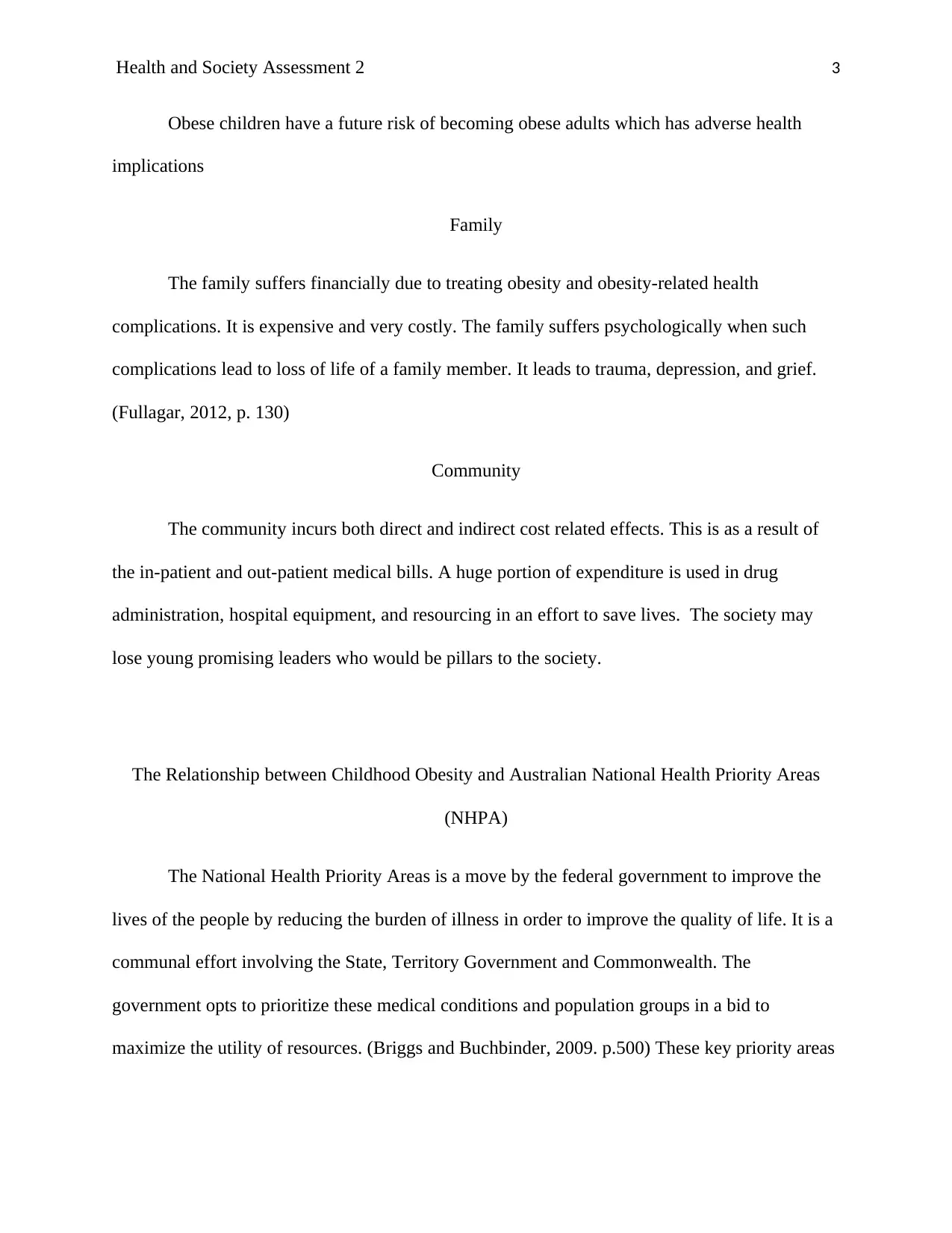
Health and Society Assessment 2 3
Obese children have a future risk of becoming obese adults which has adverse health
implications
Family
The family suffers financially due to treating obesity and obesity-related health
complications. It is expensive and very costly. The family suffers psychologically when such
complications lead to loss of life of a family member. It leads to trauma, depression, and grief.
(Fullagar, 2012, p. 130)
Community
The community incurs both direct and indirect cost related effects. This is as a result of
the in-patient and out-patient medical bills. A huge portion of expenditure is used in drug
administration, hospital equipment, and resourcing in an effort to save lives. The society may
lose young promising leaders who would be pillars to the society.
The Relationship between Childhood Obesity and Australian National Health Priority Areas
(NHPA)
The National Health Priority Areas is a move by the federal government to improve the
lives of the people by reducing the burden of illness in order to improve the quality of life. It is a
communal effort involving the State, Territory Government and Commonwealth. The
government opts to prioritize these medical conditions and population groups in a bid to
maximize the utility of resources. (Briggs and Buchbinder, 2009. p.500) These key priority areas
Obese children have a future risk of becoming obese adults which has adverse health
implications
Family
The family suffers financially due to treating obesity and obesity-related health
complications. It is expensive and very costly. The family suffers psychologically when such
complications lead to loss of life of a family member. It leads to trauma, depression, and grief.
(Fullagar, 2012, p. 130)
Community
The community incurs both direct and indirect cost related effects. This is as a result of
the in-patient and out-patient medical bills. A huge portion of expenditure is used in drug
administration, hospital equipment, and resourcing in an effort to save lives. The society may
lose young promising leaders who would be pillars to the society.
The Relationship between Childhood Obesity and Australian National Health Priority Areas
(NHPA)
The National Health Priority Areas is a move by the federal government to improve the
lives of the people by reducing the burden of illness in order to improve the quality of life. It is a
communal effort involving the State, Territory Government and Commonwealth. The
government opts to prioritize these medical conditions and population groups in a bid to
maximize the utility of resources. (Briggs and Buchbinder, 2009. p.500) These key priority areas
⊘ This is a preview!⊘
Do you want full access?
Subscribe today to unlock all pages.

Trusted by 1+ million students worldwide

Health and Society Assessment 2 4
include asthma, diabetes mellitus, cancer control, injury prevention, cardiovascular health, and
mental health.
Obesity is by extension a National Health Priority Area due to its association with other
health complications. Obesity has a direct relationship with diabetes mellitus, cardiovascular
diseases, and asthma.
Abdominal obesity poses a risk for cardiovascular diseases globally. Mortality and
morbidity of CVD are high on people with obesity. Such people are prone to kidney failure and
hypertension. All these conditions are interrelated with obesity. (GBD, 2015, p.20)
High sugar levels cause obesity. It puts the body under intense pressure to use insulin as a
control mechanism. This poses a threat to diabetes. Though the body secretes sufficient insulin
the body cells become unresponsive to salutary action of insulin. This is a process that happens
when Endoplasmic Reticulum (ER) sends impulses to the cell membrane to dampen insulin
receptors.
Obesity increases the risk of Asthma; the risk is more severe in children than in adults.
This is because the thick adipose tissue of an obese person can cause systemic inflammation by
use of adipokines which results in chronic inflammation. Such induced inflammation is difficult
to control since it does not respond to corticosteroids. In such a manner, asthma relates to
obesity. (Beuther, Weiss and Sutherland, 2006, p.117)
The Relationship between Childhood Obesity and 3 Social Determinants Of Health
Social Environment (Race and Ethnicity)
include asthma, diabetes mellitus, cancer control, injury prevention, cardiovascular health, and
mental health.
Obesity is by extension a National Health Priority Area due to its association with other
health complications. Obesity has a direct relationship with diabetes mellitus, cardiovascular
diseases, and asthma.
Abdominal obesity poses a risk for cardiovascular diseases globally. Mortality and
morbidity of CVD are high on people with obesity. Such people are prone to kidney failure and
hypertension. All these conditions are interrelated with obesity. (GBD, 2015, p.20)
High sugar levels cause obesity. It puts the body under intense pressure to use insulin as a
control mechanism. This poses a threat to diabetes. Though the body secretes sufficient insulin
the body cells become unresponsive to salutary action of insulin. This is a process that happens
when Endoplasmic Reticulum (ER) sends impulses to the cell membrane to dampen insulin
receptors.
Obesity increases the risk of Asthma; the risk is more severe in children than in adults.
This is because the thick adipose tissue of an obese person can cause systemic inflammation by
use of adipokines which results in chronic inflammation. Such induced inflammation is difficult
to control since it does not respond to corticosteroids. In such a manner, asthma relates to
obesity. (Beuther, Weiss and Sutherland, 2006, p.117)
The Relationship between Childhood Obesity and 3 Social Determinants Of Health
Social Environment (Race and Ethnicity)
Paraphrase This Document
Need a fresh take? Get an instant paraphrase of this document with our AI Paraphraser
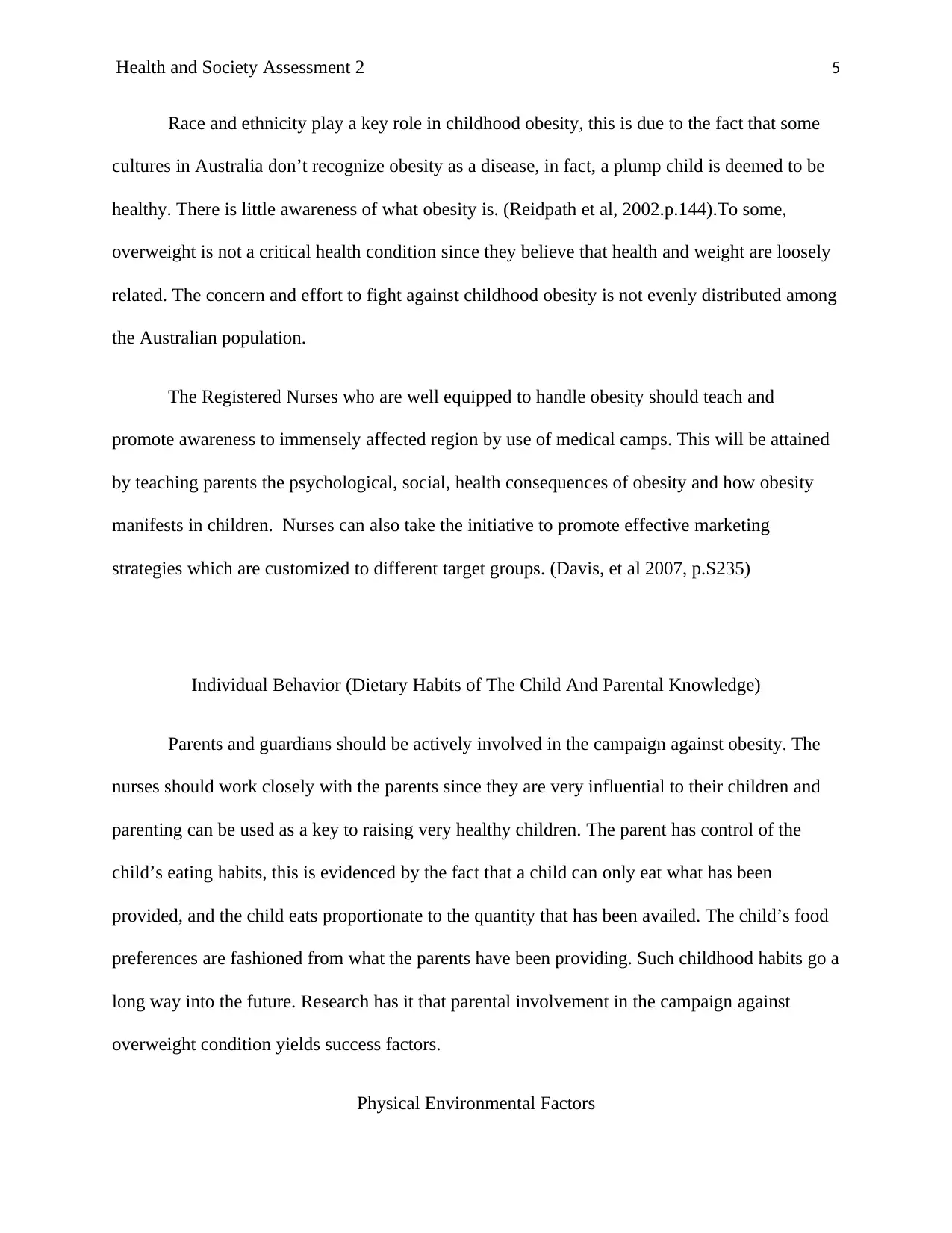
Health and Society Assessment 2 5
Race and ethnicity play a key role in childhood obesity, this is due to the fact that some
cultures in Australia don’t recognize obesity as a disease, in fact, a plump child is deemed to be
healthy. There is little awareness of what obesity is. (Reidpath et al, 2002.p.144).To some,
overweight is not a critical health condition since they believe that health and weight are loosely
related. The concern and effort to fight against childhood obesity is not evenly distributed among
the Australian population.
The Registered Nurses who are well equipped to handle obesity should teach and
promote awareness to immensely affected region by use of medical camps. This will be attained
by teaching parents the psychological, social, health consequences of obesity and how obesity
manifests in children. Nurses can also take the initiative to promote effective marketing
strategies which are customized to different target groups. (Davis, et al 2007, p.S235)
Individual Behavior (Dietary Habits of The Child And Parental Knowledge)
Parents and guardians should be actively involved in the campaign against obesity. The
nurses should work closely with the parents since they are very influential to their children and
parenting can be used as a key to raising very healthy children. The parent has control of the
child’s eating habits, this is evidenced by the fact that a child can only eat what has been
provided, and the child eats proportionate to the quantity that has been availed. The child’s food
preferences are fashioned from what the parents have been providing. Such childhood habits go a
long way into the future. Research has it that parental involvement in the campaign against
overweight condition yields success factors.
Physical Environmental Factors
Race and ethnicity play a key role in childhood obesity, this is due to the fact that some
cultures in Australia don’t recognize obesity as a disease, in fact, a plump child is deemed to be
healthy. There is little awareness of what obesity is. (Reidpath et al, 2002.p.144).To some,
overweight is not a critical health condition since they believe that health and weight are loosely
related. The concern and effort to fight against childhood obesity is not evenly distributed among
the Australian population.
The Registered Nurses who are well equipped to handle obesity should teach and
promote awareness to immensely affected region by use of medical camps. This will be attained
by teaching parents the psychological, social, health consequences of obesity and how obesity
manifests in children. Nurses can also take the initiative to promote effective marketing
strategies which are customized to different target groups. (Davis, et al 2007, p.S235)
Individual Behavior (Dietary Habits of The Child And Parental Knowledge)
Parents and guardians should be actively involved in the campaign against obesity. The
nurses should work closely with the parents since they are very influential to their children and
parenting can be used as a key to raising very healthy children. The parent has control of the
child’s eating habits, this is evidenced by the fact that a child can only eat what has been
provided, and the child eats proportionate to the quantity that has been availed. The child’s food
preferences are fashioned from what the parents have been providing. Such childhood habits go a
long way into the future. Research has it that parental involvement in the campaign against
overweight condition yields success factors.
Physical Environmental Factors
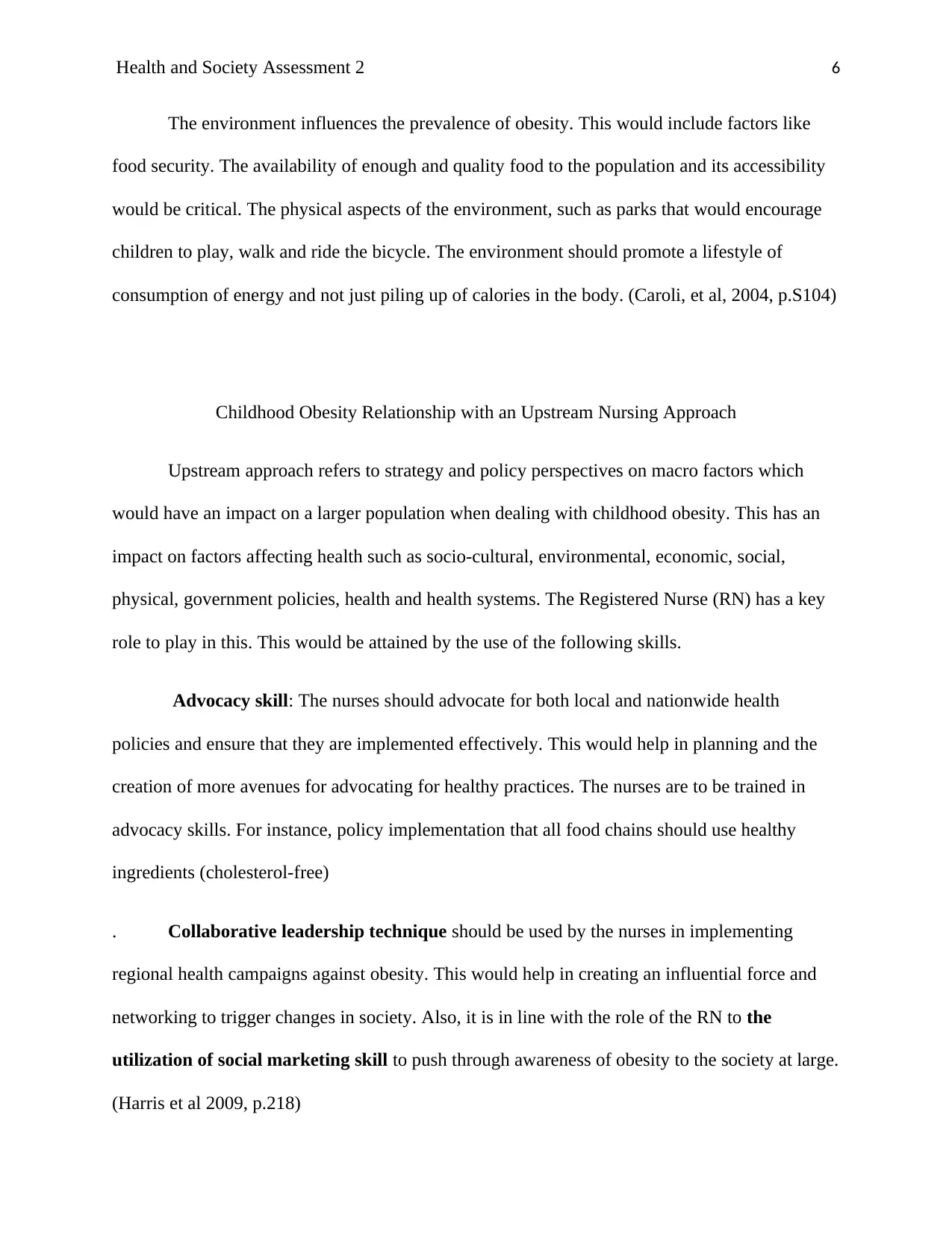
Health and Society Assessment 2 6
The environment influences the prevalence of obesity. This would include factors like
food security. The availability of enough and quality food to the population and its accessibility
would be critical. The physical aspects of the environment, such as parks that would encourage
children to play, walk and ride the bicycle. The environment should promote a lifestyle of
consumption of energy and not just piling up of calories in the body. (Caroli, et al, 2004, p.S104)
Childhood Obesity Relationship with an Upstream Nursing Approach
Upstream approach refers to strategy and policy perspectives on macro factors which
would have an impact on a larger population when dealing with childhood obesity. This has an
impact on factors affecting health such as socio-cultural, environmental, economic, social,
physical, government policies, health and health systems. The Registered Nurse (RN) has a key
role to play in this. This would be attained by the use of the following skills.
Advocacy skill: The nurses should advocate for both local and nationwide health
policies and ensure that they are implemented effectively. This would help in planning and the
creation of more avenues for advocating for healthy practices. The nurses are to be trained in
advocacy skills. For instance, policy implementation that all food chains should use healthy
ingredients (cholesterol-free)
. Collaborative leadership technique should be used by the nurses in implementing
regional health campaigns against obesity. This would help in creating an influential force and
networking to trigger changes in society. Also, it is in line with the role of the RN to the
utilization of social marketing skill to push through awareness of obesity to the society at large.
(Harris et al 2009, p.218)
The environment influences the prevalence of obesity. This would include factors like
food security. The availability of enough and quality food to the population and its accessibility
would be critical. The physical aspects of the environment, such as parks that would encourage
children to play, walk and ride the bicycle. The environment should promote a lifestyle of
consumption of energy and not just piling up of calories in the body. (Caroli, et al, 2004, p.S104)
Childhood Obesity Relationship with an Upstream Nursing Approach
Upstream approach refers to strategy and policy perspectives on macro factors which
would have an impact on a larger population when dealing with childhood obesity. This has an
impact on factors affecting health such as socio-cultural, environmental, economic, social,
physical, government policies, health and health systems. The Registered Nurse (RN) has a key
role to play in this. This would be attained by the use of the following skills.
Advocacy skill: The nurses should advocate for both local and nationwide health
policies and ensure that they are implemented effectively. This would help in planning and the
creation of more avenues for advocating for healthy practices. The nurses are to be trained in
advocacy skills. For instance, policy implementation that all food chains should use healthy
ingredients (cholesterol-free)
. Collaborative leadership technique should be used by the nurses in implementing
regional health campaigns against obesity. This would help in creating an influential force and
networking to trigger changes in society. Also, it is in line with the role of the RN to the
utilization of social marketing skill to push through awareness of obesity to the society at large.
(Harris et al 2009, p.218)
⊘ This is a preview!⊘
Do you want full access?
Subscribe today to unlock all pages.

Trusted by 1+ million students worldwide

Health and Society Assessment 2 7
References
Beuther, D.A., Weiss, S.T. and Sutherland, E.R., 2006. Obesity and asthma. American journal of
respiratory and critical care medicine, 174(2), pp.112-119.
Briggs, A.M., and Buchbinder, R., 2009. Back pain: a national health priority area in
Australia?. Medical Journal of Australia, 190(9), pp.499-502.
Caroli, M., Argentieri, L., Cardone, M. and Masi, A., 2004. Role of television in childhood
obesity prevention. International Journal of Obesity, 28(S3), p.S104.
Davis, M.M., Gance-Cleveland, B., Hassink, S., Johnson, R., Paradis, G. and Resnicow, K.,
2007. Recommendations for the prevention of childhood obesity. Pediatrics, 120(Supplement 4),
pp.S229-S253.
Fullagar, S., 2012. Governing healthy family lifestyles through discourses of risk and
responsibility. In Biopolitics and the obesity Epidemic' (pp. 116-134). Routledge.
GBD 2015 Obesity Collaborators, 2017. Health effects of overweight and obesity in 195
countries over 25 years. New England Journal of Medicine, 377(1), pp.13-27.
Gill, T.P., Baur, L.A., Bauman, A.E., Steinbeck, K.S., Storlien, L.H., Fiatarone Singh, M.A.,
Brand‐Miller, J.C., Colagiuri, S. and Caterson, I.D., 2009. Childhood obesity in Australia
remains a widespread health concern that warrants population‐wide prevention
programs. Medical Journal of Australia, 190(3), pp.146-148.
References
Beuther, D.A., Weiss, S.T. and Sutherland, E.R., 2006. Obesity and asthma. American journal of
respiratory and critical care medicine, 174(2), pp.112-119.
Briggs, A.M., and Buchbinder, R., 2009. Back pain: a national health priority area in
Australia?. Medical Journal of Australia, 190(9), pp.499-502.
Caroli, M., Argentieri, L., Cardone, M. and Masi, A., 2004. Role of television in childhood
obesity prevention. International Journal of Obesity, 28(S3), p.S104.
Davis, M.M., Gance-Cleveland, B., Hassink, S., Johnson, R., Paradis, G. and Resnicow, K.,
2007. Recommendations for the prevention of childhood obesity. Pediatrics, 120(Supplement 4),
pp.S229-S253.
Fullagar, S., 2012. Governing healthy family lifestyles through discourses of risk and
responsibility. In Biopolitics and the obesity Epidemic' (pp. 116-134). Routledge.
GBD 2015 Obesity Collaborators, 2017. Health effects of overweight and obesity in 195
countries over 25 years. New England Journal of Medicine, 377(1), pp.13-27.
Gill, T.P., Baur, L.A., Bauman, A.E., Steinbeck, K.S., Storlien, L.H., Fiatarone Singh, M.A.,
Brand‐Miller, J.C., Colagiuri, S. and Caterson, I.D., 2009. Childhood obesity in Australia
remains a widespread health concern that warrants population‐wide prevention
programs. Medical Journal of Australia, 190(3), pp.146-148.
Paraphrase This Document
Need a fresh take? Get an instant paraphrase of this document with our AI Paraphraser
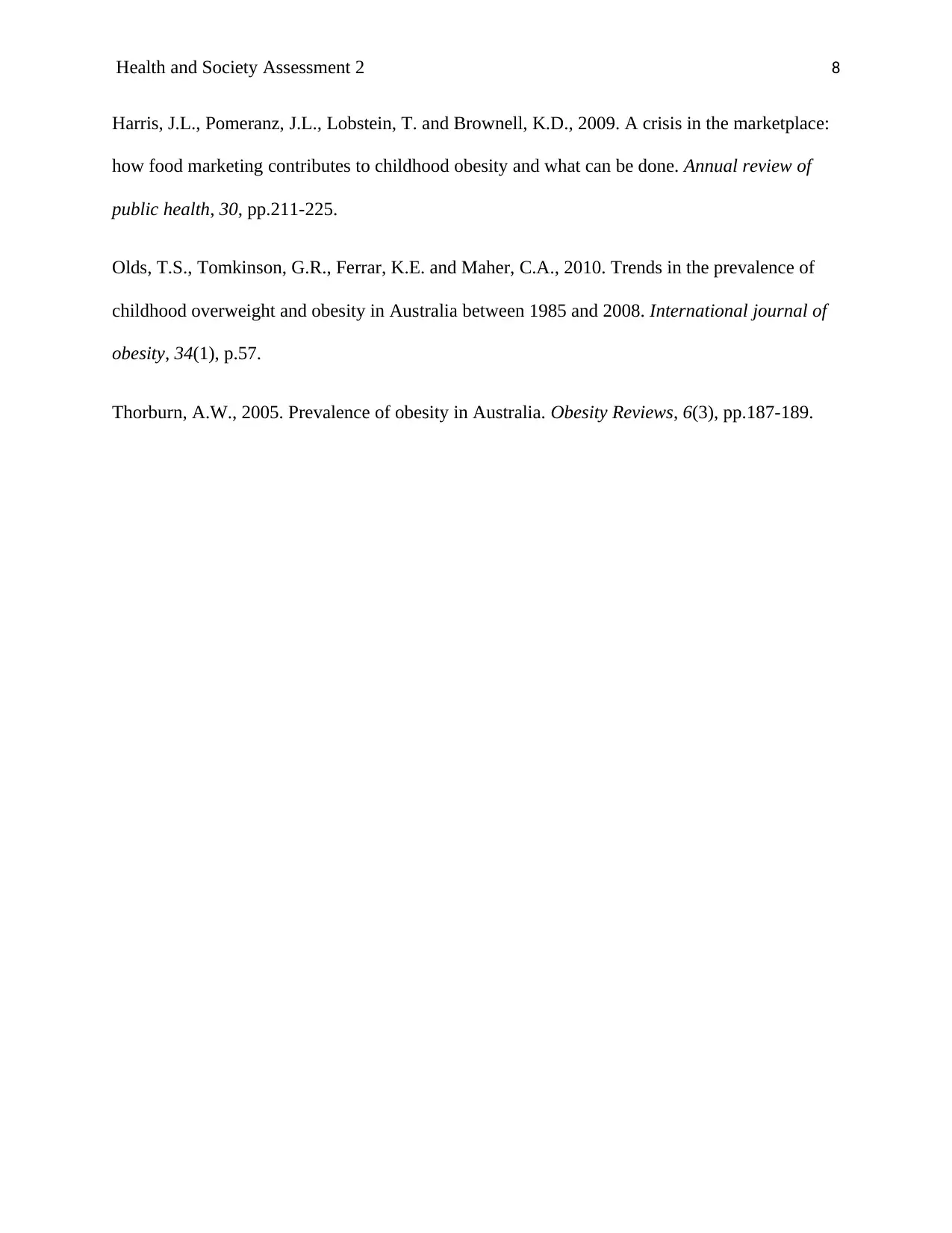
Health and Society Assessment 2 8
Harris, J.L., Pomeranz, J.L., Lobstein, T. and Brownell, K.D., 2009. A crisis in the marketplace:
how food marketing contributes to childhood obesity and what can be done. Annual review of
public health, 30, pp.211-225.
Olds, T.S., Tomkinson, G.R., Ferrar, K.E. and Maher, C.A., 2010. Trends in the prevalence of
childhood overweight and obesity in Australia between 1985 and 2008. International journal of
obesity, 34(1), p.57.
Thorburn, A.W., 2005. Prevalence of obesity in Australia. Obesity Reviews, 6(3), pp.187-189.
Harris, J.L., Pomeranz, J.L., Lobstein, T. and Brownell, K.D., 2009. A crisis in the marketplace:
how food marketing contributes to childhood obesity and what can be done. Annual review of
public health, 30, pp.211-225.
Olds, T.S., Tomkinson, G.R., Ferrar, K.E. and Maher, C.A., 2010. Trends in the prevalence of
childhood overweight and obesity in Australia between 1985 and 2008. International journal of
obesity, 34(1), p.57.
Thorburn, A.W., 2005. Prevalence of obesity in Australia. Obesity Reviews, 6(3), pp.187-189.

Health and Society Assessment 2 9
⊘ This is a preview!⊘
Do you want full access?
Subscribe today to unlock all pages.

Trusted by 1+ million students worldwide
1 out of 9
Related Documents
Your All-in-One AI-Powered Toolkit for Academic Success.
+13062052269
info@desklib.com
Available 24*7 on WhatsApp / Email
![[object Object]](/_next/static/media/star-bottom.7253800d.svg)
Unlock your academic potential
Copyright © 2020–2025 A2Z Services. All Rights Reserved. Developed and managed by ZUCOL.





